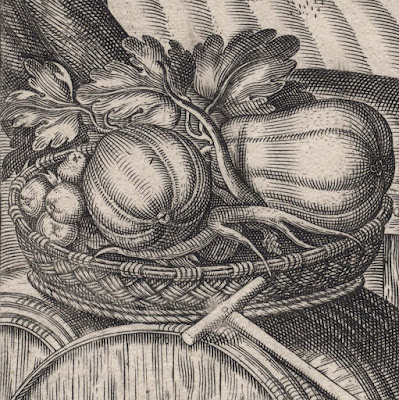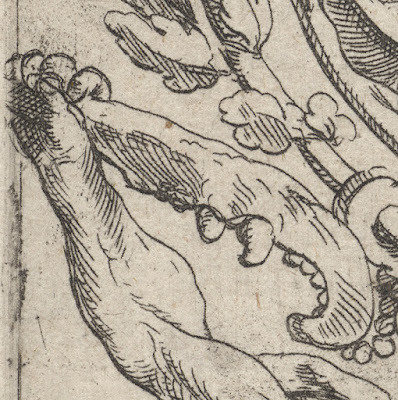Philips Galle (aka Philippe
Galle; Philippus Gallaeus) (1537–1612)
“Ops” (as inscribed on plate) (aka “Agriculture” (TIB title), 1574, plate
1 from the series of 8 engravings, “The Human Labours” (BM title) (aka “Personifications
of Industrial and Professional Life” [TIB title]), after Marten van Cleve I
(aka Marten van Cleef; Maerten van Cleve) (1527–1581) or Frans Floris (aka
Frans Floris van/de Vriendt, 1519/1520–1570), with descriptive text by Hugo Favolius (1523–1585), published initially by Philips Galle (see the impression
held by the Rijksmuseum, RP-P-1952-531), later by Johannes Boel (1592–1640)
(see the impression held by the British Museum, 1950,0520.434), and finally published
by Joannes Galle (1600–1676) in Antwerp. This impression is from the Joannes
Galle edition (as inscribed on plate on the lower image borderline).
Engraving on fine laid paper with margins.
Size: (sheet) 24.9 x 30.6 cm; (plate) 20.5
x 24.6 cm; (image borderline) 20.5 x 20.2 cm
Lettered on plate within the image
borderline: (upper left) “f.”; (upper centre) “ARTES PRACTICÆ, MAN VALES ET
HONESTÆ./ OPS.”
Inscribed on plate within the image
borderline: (on barrel at lower left) “F.Floris inuent.”; (left of centre at
lower edge) “Ioan. Galle excud.”
Lettered in Latin on plate below the
image borderline in two columns of two lines: Magna Deûm …/ … // …/ …auras./ Hugo
Fauolius caneb.”
Numbered on plate below the image
borderline: (centre) “1”.
State: iii (of iii) with the addition of
the line of text above the allegorical figure, “Ops”, and the publication
details of Joannes Galle.
TIB 5601.084:1 (Walter L Strauss &
Arno Dolders [eds.] 1987, “The Illustrated Bartsch”, vol. 56, Supplement, p. 315);
New Hollstein (Dutch & Flemish) 148.II (Frans Floris); New Hollstein (Dutch
& Flemish) 382.II (Philips Galle).
Condition: crisp, richly inked and near
faultless impression with margins in museum-quality/excellent condition (i.e.
there are no tears, holes, folds, abrasions, significant stains or foxing).
I am selling this rare engraving from 1574
for a total cost of AU$270 (currently US$191.37/EUR167.89/GBP148.14 at the time
of this listing) including postage and handling to anywhere in the world.
If you are interested in purchasing this
important and very beautiful print showcasing the agricultural aspirations of
the 16th century, please contact me (oz_jim@printsandprinciples.com)
and I will send you a PayPal invoice to make the payment easy.
This print has been sold
The Rijksmuseum offers the following
description of this print in its first state published by Philips Galle (who is
also the engraver of the print):
(transl.) “In the foreground the Roman
goddess of Agriculture Ops. She is surrounded by all kinds of agricultural and
horticultural products and tools. In the background a plowing and sowing
farmer. The print has a Latin caption and is part of a series of prints about
human activities.”
See also the description of this print
in its second state at the British Museum:
“Ops personifying agriculture; she sits
holding a sickle besides a wheatsheaf bound with grape vine and is surrounded
by the abundance of agriculture, barrels and tools etc; in the distance a field
is ploughed and a man sows seeds”
Regarding the third state (shown here)
published by Joannes Galle, the meaning of the print is now made unambiguously
clear with the Latin text inscribed at the top of the image: “ARTES PRACTICÆ,
MAN VALES ET HONESTÆ” (Google transl. “Practical art MAN is valid and honesty”)
which I understand to mean the virtues of honest work.
There is one change over the course of
the various states that catches my eye more than any other and it is the erasure
of date of the engraving’s execution (1574) on the barrel and its substitution with the name of the artist who (arguably) designed the composition: Frans Floris.
This may not seem at first to be extraordinary change to the print, but when a
viewer is reminded that one of the greatest feats of fame of this Flemish
artist was his propensity to drink copious amounts alcohol then his name
written across the barrel seems shockingly appropriate.




















































